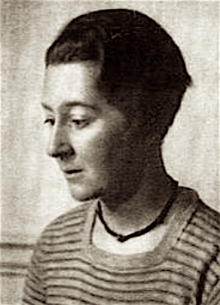
Elisabeth Whitworth Scott* was born in Bournemouth, Hampshire [now Dorset], England on 20 September 1898. The architects George Gilbert Scott (1811-1878) and George Frederick Bodley (1827-1907) were her great-uncles; and Giles Gilbert Scott (1880-1960), designer of the iconic red telephone boxes and architect of Liverpool Cathedral, was a second cousin.
She trained at the Architectural Association School in London from 1919 to 1924 and began her career as an architect with the practice of David Barclay Niven (1864-1942) and Herbert Hardy Wigglesworth (1866-1949). She then worked as an assistant to Louis de Soissons (1890-1962), and to Oliver Hill (1887-1968).
In 1927, whilst working in the office of the London architect Maurice Chesterton (1883-1962), Scott came to national attention when she won the competition to design the Royal Shakespeare Theatre in Stratford-upon-Avon. She was the only woman amomg the more than 70 architects who entered the competition. The building was completed in 1932. In 1929, Scott formed the partnership Scott, Chesterton & Shepherd with Chesterton, Alison Sleigh (1898-1972) and John Chiene Shepherd (1896-1978) to assist her in building the theatre. [Sleigh had married Shepherd in 1928 and by this time had changed her surname to Shepherd].
By 1934 Chesterton appears to have withdrawn from the partnership to be replaced by John Breakwell (c.1905-1959). The name of the practice was subsequently renamed Scott, Shepherd & Breakwell.
Notable among projects by them were the a house for a doctor in Morden' London (1933) Homer farm school for infants at Henley (1936); the Fawcett Building at Newnham College, Cambridge (completed 1938); an elementary school at Northallerton, Yorkshire (1941); the Marie Curie Hospital in Hampstead, London; and houses at Gidea Park, Essex, Fludger's Wood, Oxfordshire, and Stoke Row at Henley
A house in Clapham, Sussex designed by Scott, Shepherd & Breakwell is discussed in Small Houses £500-£2500, edited by H. Myles Wright (1937 p. 89).
During World War Two Scott returned to Bournemouth to live, Following the war she was in private practice in Bournemouth and was associated with the architect Arthur John Seal in his architectural practice A. J. Seal & Partners which in 1950 had an office at Majestic Chambers, Westover Road, Bournemouth, Hampshire. During the post-war period Scott sometimes also worked with Ronald Phillips & Partners on housing and hotels schemes in the Bournemouth area. From 1962 she worked on projects for Bournemouth borough architect's department.
Scott was elected an Associate of the Royal Institute of British Architects (ARIBA) in 1928 and a Fellow of the Royal Institute of British Architects (FRIBA) in 1946.
She married George Richards (1905-1969) in 1936 and retired from architecture in 1968. She died in Poole, Dorset on 19 June 1972.
* Her first name is sometimes, incorrectly, given as Elizabeth
Darling, Elizabeth and Walker, Lynne. AA Women in Architecture 1917-2017. London: Architectural Association and the authors, 2017
Harwood, Elain. Art Deco Britain: Buildings of the Interwar Years. London: Batsford, 2019
Harwood, Elain. Mid-Century Britain: Modern Architecture 1938-1963. London: Batsford, 2021
Howard, Sarah. Elizabeth (sic) Whitworth Scott (1898-1972): The Architect of the Shakespeare Memorial Theatre. M.Phil. thesis, University of Bath, 2009
Jellicoe, Geoffrey Alan. The Shakespeare Memorial Theatre, Stratford-upon-Avon, London: Benn, 1933
Powers, Alan. Modern. The Modern Movement in Britain. London: Merrell, 2005 pp.9, 16-1
‘Shakespeare Memorial Theatre, Stratford-on-Avon: result of competition’. RIBA Journal vol. 35, 1927–28, pp. 145–147